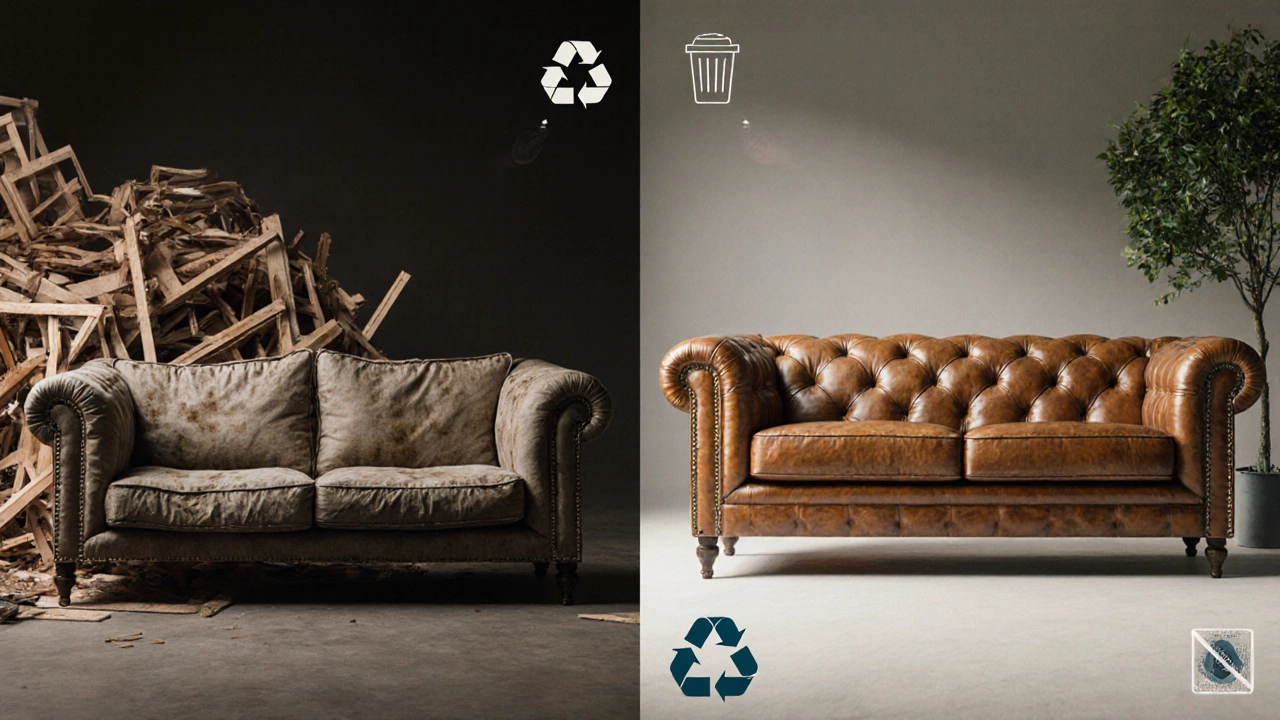 24
Nov,2025
24
Nov,2025
Couch Reupholstering Cost Calculator
Cost Comparison Calculator
Determine if it's cheaper to recover your couch or buy a new one based on your specific situation.
Results will appear here after calculation
You love your couch. It’s the one you sink into after work, the one your kids jump on, the one that’s seen movie nights, birthday parties, and midnight snacks. But now? The fabric’s frayed, the cushions are flat, and the arms are stained. You stare at it and wonder: should I fix it or just toss it and buy new?
Most people assume buying new is easier. But it’s not always cheaper. And it’s not always better. The truth? Recovering a couch can save you hundreds-or even thousands-depending on what you’re working with. But it’s not a magic fix. There are rules. There are traps. And there’s a sweet spot where reupholstering makes perfect sense.
What does it actually cost to recover a couch?
Recovering a couch means replacing the fabric, padding, and sometimes the springs or frame. It’s not just slapping new material on top. A professional reupholsterer will take the whole thing apart, inspect the frame, replace worn springs, re-stuff cushions, and then cover it with your choice of fabric. That’s labor, materials, and skill.
On average, reupholstering a standard three-seater sofa costs between $600 and $1,800. The big swing? Fabric. A basic cotton blend might run $30 per yard. A high-end linen or performance fabric like Crypton or Sunbrella can hit $100+ per yard. Most sofas need 8 to 15 yards. That’s $240 to $1,500 just for cloth.
Labor adds another $400 to $900, depending on complexity. A simple box cushion? Easy. A tufted back with nailhead trim? That’s hours of handwork. If the frame is loose or the springs are broken, expect an extra $150 to $400 for repairs. Some shops charge by the hour. Others give flat rates. Always get a written estimate.
Compare that to buying new. A basic sofa from IKEA or Walmart? $400 to $800. A mid-range one from Crate & Barrel or West Elm? $1,200 to $2,500. A high-end custom piece? $3,000 and up. So if your couch is a decent quality frame-solid wood, no major damage-reupholstering can cost less than buying new.
When does reupholstering make financial sense?
Not every couch is worth saving. But these five types almost always are:
- Antique or vintage frames - If it’s from the 1950s to 1980s, it’s likely made with kiln-dried hardwood and hand-tied springs. Modern furniture? Often particleboard and glued joints. You can’t buy that quality new for under $2,000.
- Custom or designer pieces - If you bought it from a local artisan or a brand like Roche Bobois, the original price was probably high. Reupholstering brings it back without losing the design.
- Large sectional sofas - A 7-piece sectional can cost $5,000+ new. Reupholstering it might run $2,000 to $3,500. That’s a 50%+ savings.
- High-quality mid-range sofas - If you bought it for $1,000-$1,800 five years ago and it still feels solid, it’s worth fixing. Most new budget sofas start falling apart after 3-4 years.
- Unique shapes or sizes - L-shaped, curved, or oversized? Finding a replacement that fits your space perfectly is hard-and expensive. Reupholstering keeps the exact fit.
Here’s a real example: A client in Portland had a 1978 Chesterfield sofa. The leather was cracked. The springs were still tight. The frame? Solid oak. Reupholstering with top-grain leather cost $2,100. A similar new leather sofa? $4,200. She saved $2,100-and kept a piece that looked like it belonged in a museum.
When is buying new the smarter move?
Reupholstering isn’t magic. It won’t fix bad bones. Here’s when you should walk away:
- Particleboard or MDF frames - If the frame feels flimsy, rattles when you sit, or has visible glue lines, it’s not worth saving. These frames break under pressure. No amount of new fabric fixes that.
- Broken or sagging springs - If the seat sinks in the middle like a hammock, and the springs are broken or tangled, the repair cost can balloon. A full spring replacement can add $500+.
- Water or mold damage - If the couch was soaked in a flood or has mildew smell even after cleaning, the padding and frame may be compromised. Mold grows inside foam. It’s a health risk.
- Outdated style with no emotional value - If you hate the shape, the arms, the legs, and you’ve been thinking about replacing it for a year, don’t spend $1,500 to keep something you don’t love.
- Low-end brand (Ashley, La-Z-Boy budget lines, etc.) - These are designed to be replaced, not repaired. The cost to reupholster often equals or exceeds the price of a new one.
One woman in Ohio tried to reupholster a $600 Ashley sofa. The frame was warped. The cushions were filled with shredded foam that smelled like wet dog. The reupholsterer told her: “It’s not worth it.” She bought a new $1,100 sofa from Wayfair. Saved time, stress, and money.

Fabric choices matter more than you think
Choosing the wrong fabric can turn a smart fix into a costly mistake. Here’s what to pick:
- Performance fabrics - Brands like Crypton, Sunbrella, and Revolution are stain-resistant, pet-friendly, and UV-stable. They cost $70-$120 per yard but last 10+ years. Worth it for families or pets.
- Heavy-duty cotton twill - Durable, affordable ($40-$60/yd), and easy to clean. Great for casual living rooms.
- Microfiber - Soft, affordable, and resists pet hair. But it pills over time. Not ideal for high-use homes.
- Leather - Real leather lasts decades but costs $100+/yard. Avoid bonded leather-it’s just plastic with a thin coating. It cracks in 2-3 years.
- Delicate fabrics - Silk, velvet, or linen? Beautiful, but not for kids, pets, or messy households. They stain easily and need professional cleaning.
Pro tip: Buy 10% extra fabric. Patterns need matching, and mistakes happen. Don’t skimp.
How long will a reupholstered couch last?
A well-recovered couch with a solid frame can last 15-20 years. That’s longer than most new sofas. Why? Because you’re not just covering it-you’re rebuilding it. New springs, new foam, new fabric. It’s like a full renovation.
Compare that to a new $800 sofa. Most manufacturers rate them for 5-7 years of normal use. After that, the foam compresses, the fabric fades, and the joints loosen. You’re back to square one.
Reupholstering isn’t just cheaper-it’s more sustainable. Every couch you recover keeps 200-300 pounds of furniture out of a landfill. That’s real value.

Where to find a good reupholsterer
Not all shops are equal. Here’s how to pick one:
- Ask for before-and-after photos - Real jobs, not stock images.
- Check reviews on Google and Yelp - Look for mentions of reliability, communication, and final quality.
- Ask if they do frame repairs - A good reupholsterer will fix broken joints or loose springs. If they say “we only do fabric,” walk away.
- Get a written quote - It should list fabric cost, labor, and any extra repairs. No hidden fees.
- Visit the shop - If they’re messy or disorganized, it’s a red flag. Quality shows in the details.
Some cities have specialty shops that restore antiques. Others focus on modern homes. Match the shop to your couch.
Can you reupholster a couch yourself?
Yes-but only if you’re handy and patient. It’s not beginner-friendly. You need a staple gun, fabric shears, a screwdriver, and a lot of time. You’ll also need to remove the old fabric, take notes on how it was attached, and then reassemble everything perfectly.
YouTube tutorials make it look easy. Real life? It’s messy. One wrong staple, and the fabric pulls. One misaligned seam, and it looks crooked. If you’re not confident, hire a pro. The cost of a botched job? More than hiring someone.
Only attempt it if: your couch is simple (no arms, no tufting), you have experience with sewing or woodworking, and you’re okay with spending a weekend on it.
The bottom line: Do the math
Here’s your quick decision checklist:
- Is the frame solid? (No wobble, no broken joints)
- Is the cushion foam still springy? (Not flat or crumbly)
- Is the style something you love and want to keep?
- Is the cost to recover under 60% of a new equivalent?
If you answered yes to all four, recover it. If not, buy new.
Recovering a couch isn’t just about saving money. It’s about keeping something that works, that’s built to last, and that means something to you. A new couch can match your decor. But only a recovered one can carry your memories.
Is it cheaper to recover a couch or buy a new one?
It depends. If your couch has a solid frame and you’re replacing fabric on a mid- to high-quality piece, reupholstering is often cheaper-typically 40% to 60% less than buying new. But if the frame is weak, the cushions are ruined, or it’s a cheap brand, buying new saves money and hassle.
How much does it cost to reupholster a sofa?
Reupholstering a standard three-seater sofa costs between $600 and $1,800. Fabric alone can run $240 to $1,500, depending on material. Labor adds $400-$900. Extra repairs for springs or frames can add $150-$400. High-end fabrics like leather or performance textiles push the cost higher.
What’s the best fabric for reupholstering a couch?
For families or pets, choose performance fabrics like Crypton, Sunbrella, or Revolution-they’re stain-resistant and durable. For a classic look, heavy cotton twill works well. Avoid delicate fabrics like silk or velvet unless the couch is in a low-traffic room. Real leather lasts decades but costs more. Skip bonded leather-it peels quickly.
Can you reupholster a couch yourself?
Yes, but it’s only worth it if you’re experienced with tools and sewing. You need to disassemble the couch, match patterns, staple evenly, and reassemble everything precisely. Most DIY attempts end up crooked or loose. For anything complex-tufting, arms, or curved backs-hire a professional.
How long does a reupholstered couch last?
A well-recovered couch with a solid frame and new foam and springs can last 15 to 20 years. That’s longer than most new sofas, which often start showing wear after 5-7 years. Reupholstering rebuilds the couch from the inside out, giving it a second life.




